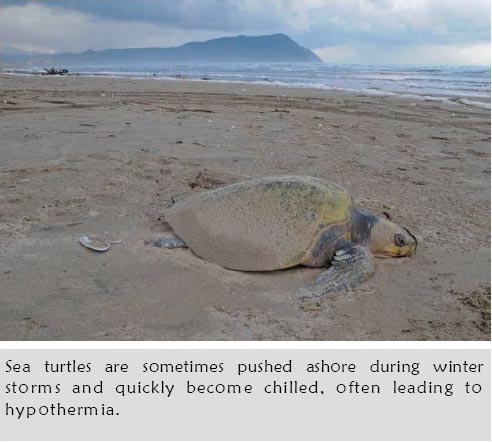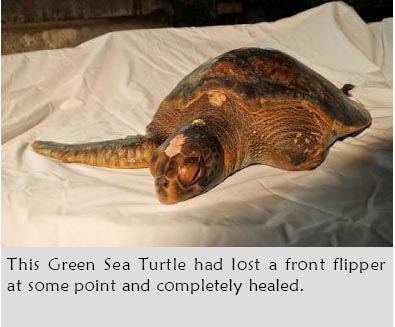
Sea Turtle Rescue
It’s a long shot at best. By the time giant sea turtles are discovered
on windy local beaches, they are usually hypothermic and can
barely move. These cold-blooded creatures were simply not built
for the Pacific Northwest’s cold, windy, wet winters.
Their arrival is accidental. Sea turtles riding the warm California
Current out at sea are sometimes pushed ashore by winter storms.
In the colder near-shore waters and wind, their body temperatures
drop rapidly and they begin to suffer from hypothermia. If they even
make it ashore, their chances of survival are very low.
On December 17, 2012 two sea turtles washed ashore in the region.
The first, a Green Sea Turtle, was found near 6th Avenue in Seaside. The second, an

Olive Ridley’s turtle, was
discovered partially buried
in the sand in Gearhart. Both were retrieved and transported to the Seaside
Aquarium.
The Seaside Aquarium is not equipped to rehabilitate sea turtles; it takes them
in and starts the delicate process of warming the animals while another
aquarium, usually the Oregon Coast Aquarium, comes to retrieve the turtles.
If rehabilitation is successful in a venue like the Oregon Coast Aquarium,
 the turtles are then sent to a facility in Southern California and released into the
wild. There are many steps in the process, and the animals are often very sick,
but the occasional success makes the effort worthwhile.
the turtles are then sent to a facility in Southern California and released into the
wild. There are many steps in the process, and the animals are often very sick,
but the occasional success makes the effort worthwhile.
 After removing a turtle from the beach, the next step is to warm it up. If this
is done too quickly, the turtle will go
into shock. Turtles are placed in a
sheltered, unheated area until they
adjust to that temperature and then
are slowly heated. This process can
take hours.
After removing a turtle from the beach, the next step is to warm it up. If this
is done too quickly, the turtle will go
into shock. Turtles are placed in a
sheltered, unheated area until they
adjust to that temperature and then
are slowly heated. This process can
take hours.
Although turtle strandings are not
common, winter storms bring a few
sea turtles ashore each year. Green
Sea Turtles are the most common,
but occasionally Olive Ridley and
Loggerheads also wash ashore.
|


